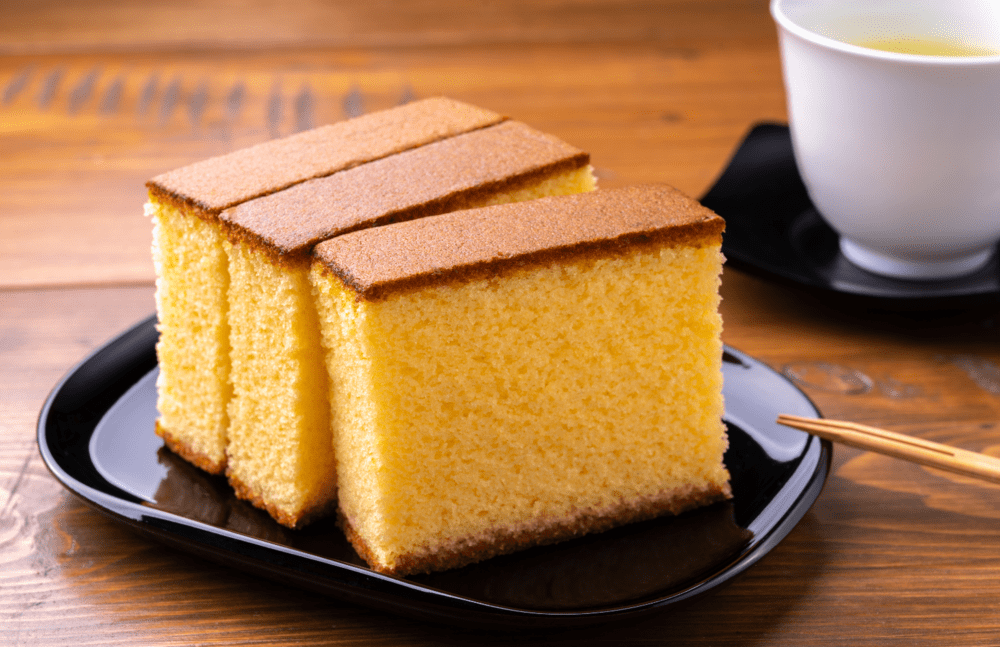

Where Did It Originally Come From?
Castella, known as "kasutera" in Japan, has an intriguing history that begins far from its current home. The cake's roots trace back to Portugal, where it was known as "Pão de Ló." Portuguese missionaries and traders brought the recipe to Japan in the 16th century during the Nanban trade period. The cake quickly gained popularity among the Japanese, who appreciated its delicate sweetness and unique texture. Over time, Castella evolved to suit Japanese tastes and became a beloved traditional confection.

Differences Between Japanese Castella and the Original
The original Portuguese Pão de Ló and the Japanese Castella, while sharing a common origin, have significant differences. The Portuguese version is often lighter and airier, resembling a sponge cake with a slightly crispy crust. It is typically flavored with citrus or almond. In contrast, Japanese Castella is denser and more moist, with a fine, even crumb. The Japanese version relies on just a few key ingredients: flour, sugar, eggs, and starch syrup, which contribute to its smooth texture and rich flavor. Additionally, Japanese Castella is traditionally baked in square or rectangular molds, creating its characteristic shape.

Evolution of Castella Over Time
Since its introduction to Japan, Castella has undergone numerous transformations. During the Edo period, the recipe was adapted to include local ingredients, such as rice flour and Japanese sugar. The baking techniques also evolved, resulting in the distinctively moist and sweet cake known today. In modern times, variations of Castella have emerged, incorporating flavors like matcha, honey, and brown sugar. Despite these changes, the fundamental elements of the cake have remained consistent, preserving its historical essence while embracing contemporary tastes.

How to Make Japanese Castella at Home
Ingredients
- 6 large eggs
- 200g (1 cup) granulated sugar
- 150g (1¼ cups) bread flour
- 2 tablespoons honey, mixed with 2 tablespoons hot water
- 2 tablespoons milk
Instructions
- Preheat your oven to 160°C (320°F). Line a square or rectangular baking pan with parchment paper.
- In a large bowl, beat the eggs using an electric mixer until frothy. Gradually add the sugar while continuing to beat the mixture until it becomes thick and pale.
- Sift the bread flour into the egg mixture, folding gently to combine. Be careful not to deflate the batter.
- Add the honey-water mixture and milk, folding until the batter is smooth and well incorporated.
- Pour the batter into the prepared pan, smoothing the top with a spatula.
- Bake for 50-60 minutes, or until the top is golden brown and a toothpick inserted into the center comes out clean.
- Remove from the oven and immediately cover with aluminum foil to retain moisture. Allow the cake to cool in the pan before slicing into thick, even pieces.
By following these steps, you can enjoy a homemade version of this beloved Japanese confection, bringing a taste of Japan to your kitchen.
Description of Modern Castella
Famous Castella Makers and Brands in Japan
Notable Castella Makers in Japan
Several renowned makers have mastered the art of Castella, contributing to its enduring popularity. One of the most famous is Fukusaya, founded in Nagasaki in 1624. Fukusaya's Castella is revered for its rich flavor and perfect texture, achieved through centuries-old techniques. Another notable maker is Bunmeido, established in 1900, which offers a variety of Castella flavors, including honey and chocolate. Shooken, another distinguished brand, is known for its delicate, finely-textured Castella that melts in the mouth.
Where to Buy Castella in Japan
Convenience Stores
In Japan, Castella can be conveniently purchased at many local convenience stores. These stores often stock a variety of packaged Castella cakes, making it easy for both locals and tourists to enjoy this sweet treat on the go.

Department Stores like Isetan Shinjuku and Ginza Mitsukoshi

For those seeking a more premium Castella experience, department stores like Isetan in Shinjuku and Mitsukoshi in Ginza offer high-quality Castella from renowned makers. These stores provide a wide selection of flavors and styles, perfect for gifting or savoring a special treat.
Flagship Stores of Famous Makers
The flagship stores of famous Castella makers are must-visit locations for any Castella enthusiast. Fukusaya has its main store in Nagasaki, where visitors can experience the authentic taste of their traditional Castella. Bunmeido's flagship store, also in Nagasaki, offers a variety of Castella options, including limited edition flavors. Shooken, known for its fine-textured Castella, can be found in various locations throughout Japan, including their main store in Tokyo.
Fukusaya co.,ltd. Main Store
Adress:3-1 Funadaikumachi, Nagasaki, 850-0904, Japan
Castella Fukusaya
Adress:1 Chome-8-1 Marunouchi, Chiyoda City, Tokyo 100-0005, Japan
Conclusion
Castella, with its rich history and delightful taste, remains a cherished part of Japanese confectionery culture. From its origins in Portugal to its evolution in Japan, the cake has retained its fundamental qualities while adapting to new flavors and techniques.
Castella, with its rich history and delightful taste, remains a cherished part of Japanese confectionery culture.
This adaptability and enduring appeal underscore why Castella is not just a dessert but a symbol of cultural exchange and culinary artistry.
If you're interested in other Japanese snacks, check out japanbite.com for more Japanese snack!



